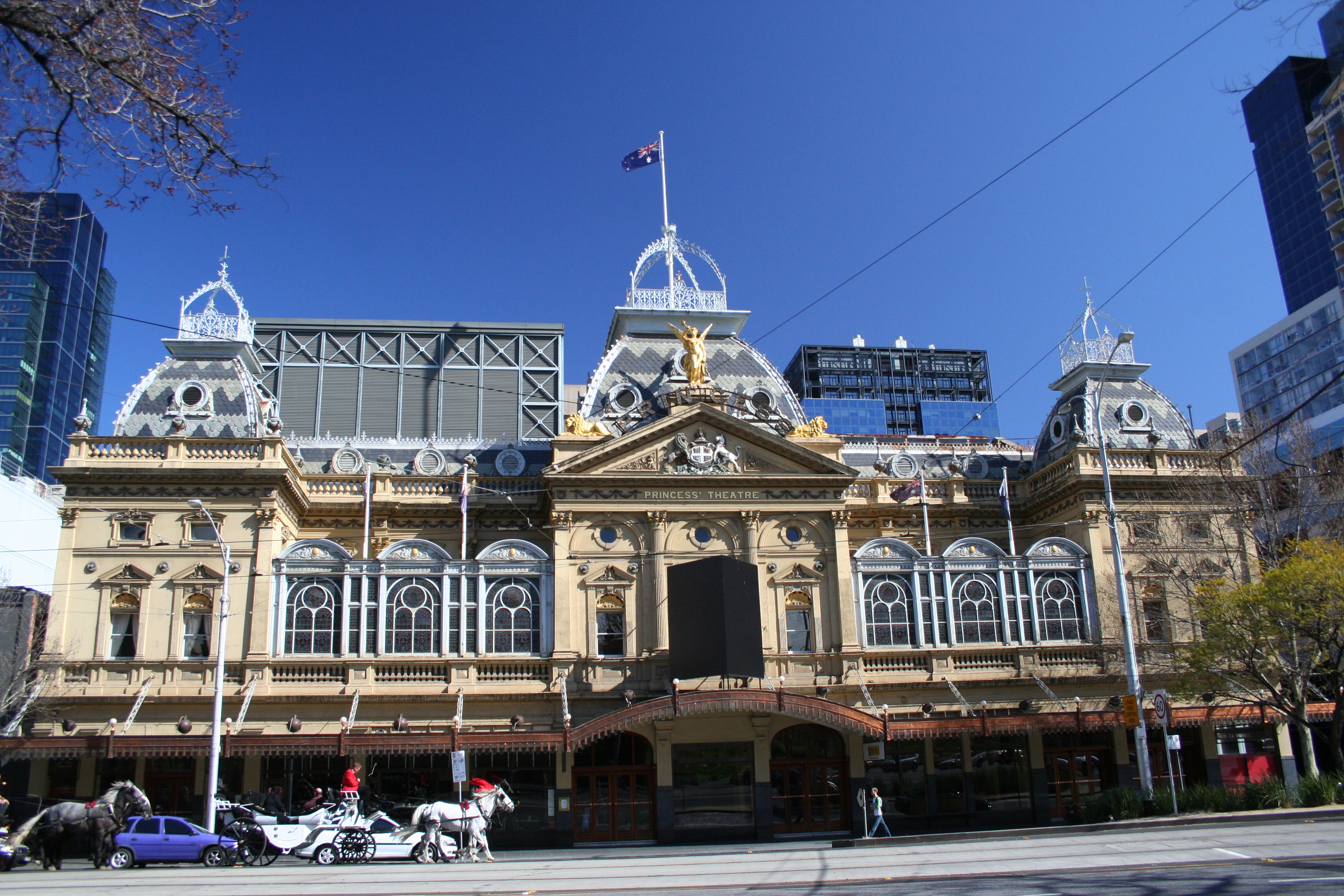- Princess Theatre, Melbourne
Infobox Theatre
name = Princess Theatre
caption = Spring Street facade
address = 163 Spring Street
city =Melbourne
country =Australia
designation =Victorian Heritage Register
latitude =
longitude =
architect = William Pitt
owner = Marriner Theatres
capacity = 1488 seats
type =
opened = 1857
yearsactive = 1857-
rebuilt =
closed =
othernames =
production =
currentuse = musicals, opera
website = www.marrinertheatres.com.au/hireprincess.htmThe Princess Theatre is a 1488-seat
theatre inMelbourne ,Australia .It is listed by the
National Trust of Australia and is on theVictorian Heritage Register .History
It was first erected in 1854 by actor-manager
George Coppin , who would create Melbourne's theatre land. He already owned the Olympic in Stephen Street, installed gas lights in November 1855 into Astley's, and then he would go on to take over the Theatre Royal in Bourke Street.The Princess Theatre is the second building on the present site - the first being Astley's Amphitheatre which opened in 1854 containing a central ring for equestrian entertainment and a stage at one end for dramatic performances. It was named in honour of the Astley Royal Amphitheatre, near Westminster Bridge, London
In 1857, the amphitheatre was renovated and the facade extended, then re-opening as the Princess Theatre and Opera House. By 1885, the partnership of
J. C. Williamson ,George Musgrove andArthur Garner , had been formed and they became known as "The Triumvirate", the business becoming known as J. C. Williamson's. The triumvirate resolved to build a new theatre.Completed in
1866 to the design of architect William Pitt; George Gordon to design the interior; and Cockram and Comely as the builders; re-development of the Theatre took place at a cost of £50,000. The design is in the exuberantSecond Empire style, and the theatre forms part of the Victorian streetscape of Spring Street.When completed, it featured the world's first sliding or retractable roof and ceiling. It also featured state-of-the-art electrical stage lighting.
The theatre re-opened, again, on
18 December 1886 , with a performance ofGilbert and Sullivan 's "The Mikado ". The marble staircase and foyer was hailed as equal to that of theParis Opera , theFrankfurt Stadt and the Grand inBordeaux .On 26 December 1922, new owners, Benjamin John Fuller and Hugh J. Ward renovated and reopened the theatre, with a performance of "The O'Brien Girl".
In 1987,
David Marriner purchased the Princess Theatre; he renovated and had the 1922 origins documented, then9 December 1989 , the theatre re-opened with the musical "Les Misérables ", followed by "The Phantom of the Opera ", establishing a new record for the longest running show ever staged in Victoria.Ghost sightings
The theatre has experienced several reported
ghost sightings. [ [http://www.abc.net.au/tv/rewind/txt/s1184926.htm The theatre ghost] from the ABC]On the evening of
3 March 1888 , the baritone Frederick Baker, known as "Federici", was performing the role of Mephistopheles inGounod 's opera "Faust". This production ended with Mephistopheles sinking dramatically through a trapdoor returning to the fires of hell with his prize, the unfortunate Dr Faustus. The audience was spellbound. As the audience held its collective breath as Federici was lowered down through the stage into this basement, he had a heart attack and died immediately. They laid him on the floor, lifeless, in his crimson vestments. He never came back onstage, never took the bows. When the company was gathered together to be told that Federici had died, they asked, "When?". Being told of what had happened at the end of the opera, they said, "He's just been onstage and taken the bows with us." Since then, many people who have never heard of the Federici story have claimed to see a ghostly figure in evening dress at the theatre. For many years, the third-row seat in the dress circle was kept vacant in his honour. [Graeme Blundell , "Marvellous Meelbourne" article in "The Age ", 27-28 August 2005]When a documentary was made nearly 80 years later, by
Kennedy-Miller in the early 1970s, a photograph of the film set revealed an ashen-faced, partly transparent observer. No-one on the set saw the figure on that day; only the photograph revealed 'the ghost'.Use
Restored in 1989, the theatre is regarded as Melbourne's home for international musical productions, including:
*"Les Misérables " (1989)
*"The Phantom of the Opera " (1990)
*"Cats" (1993)
*"West Side Story " (1994)
*"Disney's Beauty and the Beast"
*"Chess"
*"The Boy from Oz "
*"The Importance of Being Earnest "
*"The Sound of Music " (2000)
*"Mamma Mia! " (2002)
*"The Producers" (2004)
*"Swan Lake on Ice " (2006)
*"Dirty Dancing " (2006)
*"Kiss Me, Kate " (2006)
*"The Phantom of the Opera " (2007)
*"Guys and Dolls " (2008)
*"Jersey Boys " (2009)
*"The Witches of Eastwick " 2002It has also been used as a venue for theMelbourne International Comedy Festival , including the stage showPuppet Up! in 2007.References
External links
* [http://www.marrinertheatres.com.au/ Marriner Theatres]
* [http://melbourne.citysearch.com.au/arts/viewContent/1119945819575/1137557095581 What's on at Princess Theatre - Citysearch Melbourne]
Wikimedia Foundation. 2010.
